What is a motion rule for a dilation that creates a reduction?
A. (x, y) --> (3x, 3y)
B. (x, y) --> (x, -y)
C. (x, y) --> (0.25x, 0.25y)
D. (x, y) --> (x + 0.25, y + 0.25)
C. (x, y) --> (0.25x, 0.25y)
True or False?
A rotation results in changed area.
Translations preserve congruence.
Dilations change area.
Rotations change perimeter.
False
True
True
False
True or false? Rotations create a larger image.
False
What is the motion rule for a reflection across the x-axis?
(x, y) --> (x, -y)
A square has an area of 25 square meters. The square is dilated by a scale factor of 2. What is the area of the new square?
A. 50
B. 100
C. 625
D. 12.5
B. 100
What transformation is this?
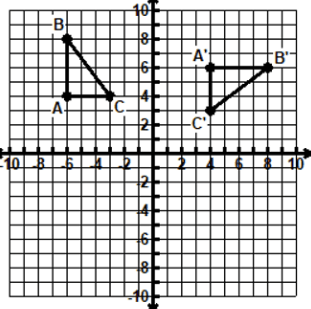
90 clockwise Rotation
270 counterclockwise Rotation
What kind of transformation preserves orientation but not congruence?
Dilations
True or False? This is a motion rule for a rotation.
(x, y) --> (-x, y)
False
A. (x, y) --> (-4x, 2y)
B. (x, y) --> (x - 4, y +2)
C. (x, y) --> (y, -x)
D. (x, y) --> (x + 4, y - 2)
B. (x, y) --> (x - 4, y +2)
What transformation is this? What motion rule would go with this transformation?
A. (-x, y)
B. (x, y) --> (x + 9, y - 8)
C. (2x, 2y)
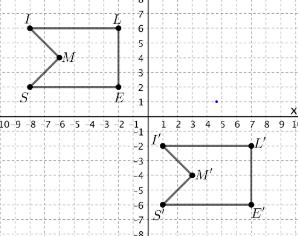
Translation
B
What transformation is this?
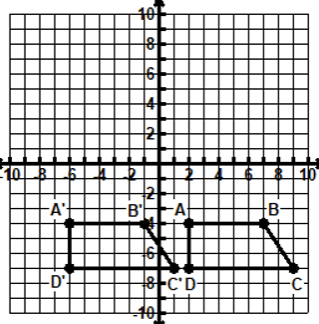
Translation
What kind of transformation preserves orientation and congruence?
A. Rotation
B. Reflections
C. Translations
D. Dilations
Translations and Rotations
True or False? Rotations preserve congruence.
True
What motion rule matches this transformation?
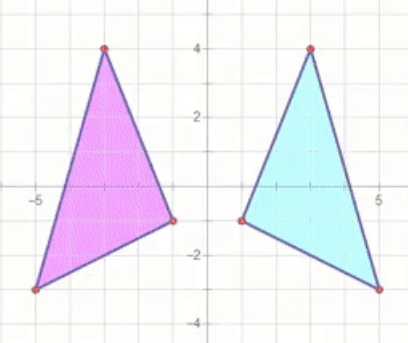
(x, y) --> (-x, y)
What transformation is this? What motion rule matches this transformation?
A. (x, y) --> (x - 3, y - 3)
B. (x, y) --> (y, -x)
C. (0.33x, 0.33y)
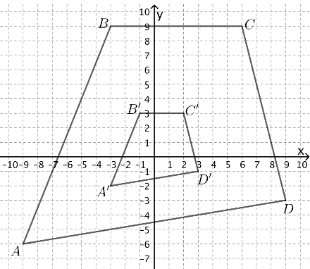
C
Create a motion rule that would result in an enlarged dilation.
Create a motion rule that would results in a reduced dilation.
Scale factor greater than one.
Scale factor less than one.
Which motion rule does not preserve congruence?
A. (x, y) --> (-x, -y)
B. (x, y) --> (x + 4, y - 8)
C. (x, y) --> (2x, 2y)
D. (x, y) --> (x, -y)
C. (x, y) --> (2x, 2y)
What motion rule matches this transformation?
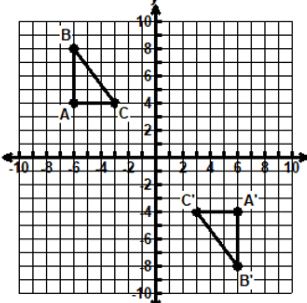
(x, y) --> (-x, -y)
True or False?
Translations preserve orientation.
Translations preserve congruence.
True
True
What kind of transformation is this? What motion rule matches the transformation?
A. (x, y) --> (x + 2, y - 3)
B. (x, y) --> (2x, 2y)
C. (x, y) --> (x, -y)
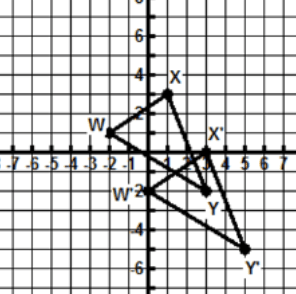
Translation
A
What side length corresponds to GF?
What angle corresponds to angle M?
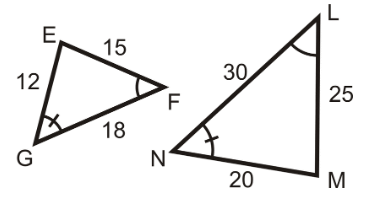
LN
E
Which motion rule(s) do not preserve orientation?
A. (x, y) --> (4x, 4y)
B. (x, y) --> (x + 2, y - 3)
C. (x, y) --> (x, -y)
D. (x, y) --> (y, -x)
C. (x, y) --> (x, -y)
True or false?
Rotations result in a new area.
Rotations do not change perimeter.
Rotations preserve congruence.
Rotations preserve orientation.
False
True
True
True
True or False?
Reflections preserve orientation.
Reflections preserve congruence.
Reflections do not change area or perimeter.
False
True
True
A triangle has an area of 8 square centimeters. The triangle has been dilated by a scale factor of 1/2. What is the new area?
2 units squared.